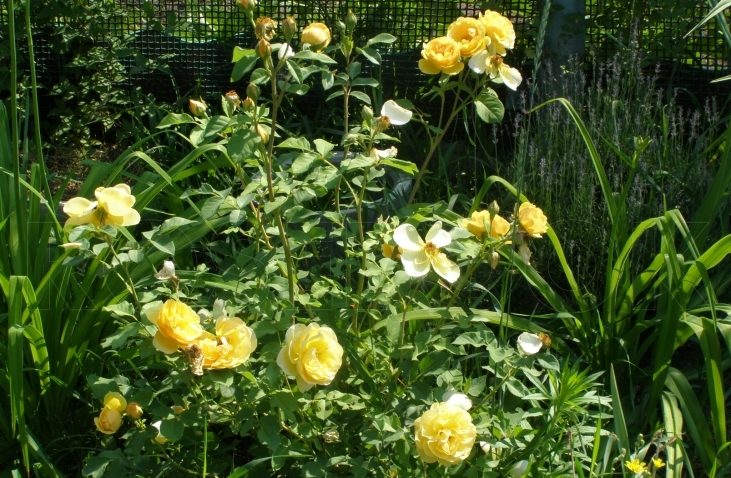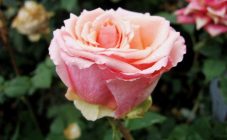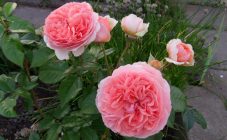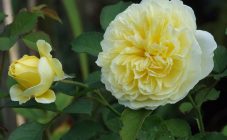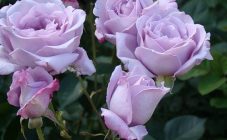Content:
The Graham Thomas rose variety is, without exaggeration, unique. It has a special history and an interesting description. From its name alone, we can conclude that the culture belongs to the group of English roses, distinguished by refined beauty and elegance. Even the most sophisticated gardeners cannot pass by this beauty.
General information about culture
Representatives of English roses are sophisticated and elegant flowers that were very popular at the beginning of the 20th century, and returned to fashion in the second half of the 80s. The famous breeder David Austin in 1983 bred a unique variety, which he decided to name after his friend Graham Thomas.
The birthplace of the Graham Thomas rose is England, and here, confessing love, lovers are sure to be presented with two beautiful yellow roses.
Due to its incredible aroma and unusual cup-shaped buds during the exhibition in Chelsea, this variety of roses did not leave anyone indifferent. It is also worth mentioning that the Graham Thomas variety was obtained by crossing two varieties of roses - Iceberg and Charles Austin.
Characteristics and features of the variety
The color palette of the Graham Thomas rose petals includes many different shades of yellow, which tend to differ depending on what climatic conditions prevail in the planting region.
The group of the main distinguishing features of the plant includes the following:
- the buds are cupped and have an amazing double structure, their diameter is 7-10 cm;
- one peduncle, on average, consists of 75-80 petals, which serve as protection for the center of the bud and only slightly open it due to their curved shape;
- as for the inflorescences, they consist of 8 flowers, characterized by a sweet and light aroma.
The shoots of the rose bushes are very branchy, droop to the ground and have dark green shiny foliage. Indicators of width and height depend on the climatic conditions in the region of growing roses. But, on average, the width of one bush is 1 m, and in height it can reach 1.5-3.5 m. The flowering period of Graham Thomas rose bushes lasts all summer.
Features of growing and recommendations for caring for a rose
To plant Graham Thomas rose seedlings, preference should be given to sunny areas, as well as those that are in partial shade. When choosing a site, you need to be guided by the fact that the Graham Thomas English rose must be in direct sunlight for at least 6-7 hours a day. Experienced flower growers recommend making sure that the garden bed is well ventilated.
The growth and development of the plant depends on how the garden bed is chosen correctly: in sufficiently illuminated and sunny areas, compact bushes can be grown that will bloom profusely, and tall shrubs with small inflorescences grow in a shaded place.
The procedure for planting a Graham Thomas rose can be carried out with the onset of spring or in the second half of autumn. The landing algorithm consists of several points, namely:
- Planting material should be pre-prepared for planting. To do this, you need to hold it in a root-forming liquid for a day, and then plant it in open ground according to the scheme 50 * 50 * 50 cm (the width, depth and distance between seedlings should be equal).
- In the process of preparing the planting holes, they must be watered abundantly, using at least 1 bucket of water per hole.
- It is necessary to carefully spread the root system, place it in the hole, and then pour the substrate on top so that the deepening of the graft bud is 7 cm.The final stage is the compaction of the soil, and the next day the English rose Graham Thomas must be spud and watered with abundant water.
The Graham Thomas variety is distinguished by English pedantry, and it is for this reason that plant care procedures must be performed regularly and correctly. If you follow the basic rules of care, then this will definitely lead to the receipt of a beautiful well-groomed plant that will delight the eye with its lush flowering.
An important component of success in growing this variety of rose is moisture. Watering should be timely, but moderate. When the top layer of the earth dries up, you need to immediately start watering. The volumes of water always depend on what climatic conditions are.
At the beginning of the growing season, the planted seedlings will need to be fertilized with calcium and phosphorus. This is necessary in order for the buds on the bushes to successfully set (it is best to feed the roses in early May or June). With the onset of autumn, it is recommended to feed roses with potassium.
You need to cut a rose based on intuition and personal preferences, as well as how the florist sees the landscape design of his site. Those drooping shoots that have been affected by various diseases are subject to mandatory pruning. You also need to remove faded peduncles.
Rose breeding methods Graham Thomas
As for the propagation of roses, it is possible to do this with the help of layering and cuttings. The most popular is the method of propagation by layering. This will require strong young shoots, from which you need to cut off the tip, and then insert a small stick or match there. Then it is necessary to attach the stalk to the ground, sprinkle with drainage and water.
The breeding process should be carried out in the second half of July or early August, and with the onset of spring, ready-made seedlings can be separated from the mother shrubs.
If we take into account reproduction by cuttings, then it is not as popular as the previous method. For cuttings, preference should be given to those branches that are already fully strengthened. As successful seedlings are those that have already appeared 2-3 leaves, but 2 of them must be removed. The cuttings should be planted at a distance of 20 cm into the ground, which should be pre-fertilized, loosened and moistened.
Disease and pest control
Almost all varieties of English roses react negatively to excess moisture, which is often the causative agent of various diseases. For preventive purposes, drainage must be introduced into the soil, and excessive watering of the rose must be avoided. During the rainy season, be sure to shake off the drops from the buds and foliage of the plant.
The most common ailment of these beautiful flowers is gray mold caused by excessive moisture and prolonged rainfall. It is a fungal infection that affects the root system of a shrub. The first alarming signal of the disease is decay of shoots and inflorescences. The areas that have been affected by the infection must be cut off immediately, and then the soil must be disinfected using substances such as Alirin-B or Fitosporin-M.
Advantages and disadvantages of the variety
Any plant has a number of certain pros and cons that you need to pay attention to before starting to grow a crop, and the Graham Thomas rose is no exception.
So, the advantages of this variety include the following:
- due to high and persistent immunity, rose bushes in rare cases are affected by diseases and various pests;
- the variety is able to quickly root when planted in open ground;
- shrubs bloom magnificently not only in areas illuminated by direct sunlight, but also in partial shade;
- on each shoot, buds are formed in abundant quantities, which serves as a bright decoration for the shrub and the suburban area, in general.
This rose variety has some disadvantages, but it is worth noting that there are significantly fewer of them than advantages. So, the disadvantages of the Graham Thomas rose include the monotony of the color scheme, which differs only in one shade of yellow. But, in most cases, they are very bright, which completely suits the florists. Also, the rose Thomas Graham reacts sharply to the slightest excess of the humidity level, which leads to unwanted diseases.
Even an aspiring florist can grow these sophisticated and elegant plants. The main condition here is the observance of all tips and recommendations regarding proper planting and care. Competent cultivation of the rose bush will certainly lead to the desired result in the form of abundant flowering in the park area.

